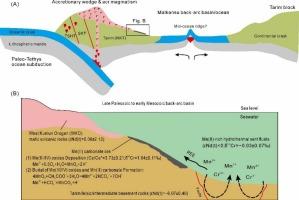Origin and metal source of the Carboniferous Ortokarnash manganese deposit in the Western Kunlun Orogen, Northwest China
IF 3.6
2区 地球科学
Q1 GEOLOGY
引用次数: 0
Abstract
The formation mechanisms of Mn(II) carbonate mineralization and the precise sources of metals in ancient sedimentary Mn ore deposits remain subjects of debate. The Ortokarnash Mn ore deposit occurred within a mixed carbonate-siliciclastic sedimentary sequence of the Upper Carboniferous Kalaatehe Formation consisting of three lithological members. In this study, detailed component-specific solution analyses were performed on same sample powders from the Ortokarnash Mn(II) carbonate ores and wall rocks. The acetic acid-soluble fractions (i.e., leachates) in Mn(II) carbonate ores show a distinct PAAS-normalized positive Ce anomalies (3.73 ± 0.21), negative Y anomalies (0.90 ± 0.03), and low Y/Ho ratios (22.42–24.84). These are typical features of modern marine hydrogenetic Mn(III/IV) oxide precipitates, indicating that the Mn(II) carbonate mineralization likely the diagenetic product of precursor Mn(III/IV) oxide reduction. The remarkable positive δ53Cr values (1.04 ± 0.11 ‰) in leachates of the Mn ores further confirm that Mn(II) carbonates formed during diagenesis through the reduction of Mn(III/IV) oxides originally deposited from an oxygenated water column. Moreover, the PAAS-normalized REE + Y patterns for leachates in associated wall rocks from the 3rd Member are characterized by no meaningful or a slight positive Ce anomalies (1.03–1.49, mean = 1.17), which is indicative of an active Mn(III/IV) oxide shuttle across a redox-stratified basin water column.
The δ53Cr values (−0.17 to 0.04 ‰) in leachates of the associated wall rocks from the 3rd Member lie within or close to the Bulk Silicate Earth, and thus likely indicate discharge of Cr(III) of submarine hydrothermal origin in the local basin. The acetic acid-insoluble fractions (i.e., residues) in wall rocks are characterized by low Th/Sc (0.02–0.24) ratios, slight chondrite-normalized light REE enrichment (Nd/YbN = 2.08 ± 0.77), primitive mantle-normalized LILEs enrichment, positive U-Pb and negative Nb-Ta-Ti anomalies, and high radiogenic Nd (–3.63 ≤ εNd(t) ≤ 3.94) and low radiogenic Sr (0.704854 ≤ (87Sr/86Sr)i ≤ 0.707710) isotope compositions, indicating that siliciclastic debris in wall rocks were likely derived from a depleted mantle source (e.g., WKO mafic volcanic rocks). By contrast, the residues in Mn(II) carbonate ores display low Al/Ti (13.63–21.85) and high Th/Sc (1.04–2.43) ratios, marked chondrite-normalized light REE enrichment (Nd/YbN = 7.52 ± 2.23), primitive mantle-normalized LILEs enrichment, positive U-Th-Pb and negative Ta-Ti anomalies, and low radiogenic Nd (εNd(t) = –6.07 ± 0.40) and high radiogenic Sr ((87Sr/86Sr)i = 0.708064 ± 0.000612) isotope compositions. These element and isotope geochemical features are consistent with that of felsic/intermediate rocks, suggesting that siliciclastic component in Mn(II) carbonate ores were likely sourced from old crustal units (e.g., Tarim felsic/intermediate basement rocks). Thus, it has been suggested that the Mn metal was likely derived from submarine hydrothermal vent fluids (δ53Cr = − 0.03 ± 0.07 ‰), while this hydrothermal vent system likely occurred on an ancient continental crust (εNd(t) = –6.07 ± 0.40).

西昆仑造山带石炭系Ortokarnash锰矿床成因及金属来源
古沉积锰矿床中锰(II)碳酸盐矿化的形成机制和金属的确切来源仍然是争论的主题。Ortokarnash锰矿床赋存于上石炭统卡拉特河组碳酸盐-硅屑混合沉积层序中,由3个岩性段组成。在本研究中,对来自Ortokarnash Mn(II)碳酸盐矿石和围岩的相同样品粉末进行了详细的组分特异性溶液分析。Mn(II)碳酸盐岩中乙酸溶组分(即浸出液)表现出明显的paas归一化正Ce异常(3.73±0.21)、负Y异常(0.90±0.03)和低Y/Ho比值(22.42 ~ 24.84)。这是现代海相氢成Mn(III/IV)氧化物沉积的典型特征,表明锰(II)碳酸盐矿化可能是前驱体Mn(III/IV)氧化物还原的成岩产物。Mn矿石浸出液δ53Cr显著正值(1.04±0.11‰)进一步证实了成岩过程中Mn(II)碳酸盐是由氧化水柱中Mn(III/IV)氧化物还原形成的。此外,三段伴生围岩中渗滤液的paas标准化REE + Y模式没有明显的Ce异常(1.03 ~ 1.49,平均值= 1.17),表明氧化还原层状盆地水柱中存在活跃的Mn(III/IV)氧化物。三段伴生围岩渗出液δ53Cr值(- 0.17 ~ 0.04‰)位于块状硅酸盐土内部或附近,可能是盆地内海底热液排放的Cr(III)。围岩中乙酸不溶组分(即残余物)具有低Th/Sc(0.02 ~ 0.24)比、轻微球粒陨石归一化轻REE富集(Nd/YbN = 2.08±0.77)、原始地幔归一化LILEs富集、U-Pb正异常和Nb-Ta-Ti负异常、高放射性Nd(-3.63≤εNd(t)≤3.94)和低放射性Sr(0.704854≤(87Sr/86Sr)i≤0.707710)同位素组成特征。表明围岩中的硅屑碎屑可能来自枯竭的地幔源(如WKO基性火山岩)。Mn(II)碳酸盐矿石中残余Al/Ti低(13.63 ~ 21.85),Th/Sc高(1.04 ~ 2.43),球粒陨石归一化轻REE富集(Nd/YbN = 7.52±2.23),原始地幔归一化LILEs富集,U-Th-Pb正异常,Ta-Ti负异常,低放射性Nd(εNd(t) = -6.07±0.40)和高放射性Sr ((87Sr/86Sr)i = 0.708064±0.000612)同位素组成。这些元素和同位素地球化学特征与长英质/中质岩石一致,表明锰(II)碳酸盐岩中硅屑组分可能来源于古老的地壳单元(如塔里木长英质/中质基底岩)。因此,认为锰金属可能来源于海底热液喷口流体(δ53Cr = - 0.03±0.07‰),而该热液喷口系统可能发生于古大陆地壳(εNd(t) = -6.07±0.40)。
本文章由计算机程序翻译,如有差异,请以英文原文为准。
求助全文
约1分钟内获得全文
求助全文
来源期刊

Ore Geology Reviews
地学-地质学
CiteScore
6.50
自引率
27.30%
发文量
546
审稿时长
22.9 weeks
期刊介绍:
Ore Geology Reviews aims to familiarize all earth scientists with recent advances in a number of interconnected disciplines related to the study of, and search for, ore deposits. The reviews range from brief to longer contributions, but the journal preferentially publishes manuscripts that fill the niche between the commonly shorter journal articles and the comprehensive book coverages, and thus has a special appeal to many authors and readers.
 求助内容:
求助内容: 应助结果提醒方式:
应助结果提醒方式:


